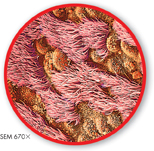Pharynx, Larynx, and Trachea Air moves through the nose to a cavity at the back of the mouth called the pharynx, or throat. The pharynx serves as a passageway for both air and food. Air moves from the pharynx into the trachea, or windpipe. When you swallow food or liquid, a flap of tissue called the epiglottis covers the entrance to the trachea, ensuring that the food or liquid goes into the esophagus.
Between the pharynx and the trachea is the larynx. The larynx contains two highly elastic folds of tissue known as the vocal cords. When muscles pull the vocal cords together, the air moving between them causes the cords to vibrate and produce sounds. Your ability to speak, shout, and sing comes from these tissues.
Mucus produced in the trachea continues to trap inhaled particles. Cilia lining the trachea sweep both mucus and trapped particles away from the lungs toward the pharynx. From there, the mucus and particles can be swallowed or spit out. This process helps keep the lungs clean and open for the important work of gas exchange.

FIGURE 33–14 Cilia Cilia in the trachea sweep mucus and debris away from the lungs. Infer What would likely happen to a person's respiratory system if the cilia were damaged by pollutants?
Lungs From the trachea, air moves into two large tubes in the chest cavity called bronchi (singular: bronchus). Each bronchus leads to one lung. Within each lung, the large bronchus divides into smaller bronchi, which lead to even smaller passageways called bronchioles. Bronchi and bronchioles are surrounded by smooth muscles controlled by the autonomic nervous system. As the muscles contract and relax, they regulate the size of air passageways.
The bronchioles continue to divide until they reach a series of dead ends—millions of tiny air sacs called alveoli (singular: alveolus). Air moving through these tubes can be compared to a motorist who takes an exit off an eight-lane highway onto a four-lane highway, makes a turn onto a two-lane road, and then proceeds onto a narrow country lane—which dead-ends. Alveoli are grouped in clusters, like bunches of grapes. A delicate network of capillaries surrounds each alveolus.
BUILD Vocabulary
MULTIPLE MEANINGS Alveolus is also the term for a honeycomb cell in a beehive or a tooth socket in the jaw.
Quick Lab
GUIDED INQUIRY
What's in the Air?

Trace the outline of a microscope slide on graph paper. Repeat four times.
Cut out the outlines and tape them to the bottom of five slides.
Pick indoor and outdoor spots to place your slides. On the back of each slide, write your initials, the date, and where you will put the slide.
Cover the front of each slide with a thin coat of petroleum jelly.
Leave the slides in the locations you chose for at least 24 hours.
Collect the slides, place them under a microscope, and count the number of particles in ten of the squares on each slide. Record your results.
Observe On which slide did you count the most particles? The fewest?
Draw Conclusions Were you surprised by the results? Why or why not?
Apply Concepts What structures in your body prevent most of these particles from entering your lungs?
Analyze and Conclude
Table of Contents
- Formulas and Equations
- Applying Formulas and Equations
- Mean, Median, and Mode
- Estimation
- Using Measurements in Calculations
- Effects of Measurement Errors
- Accuracy
- Precision
- Comparing Accuracy and Precision
- Significant Figures
- Calculating With Significant Figures
- Scientific Notation
- Calculating With Scientific Notation
- Dimensional Analysis
- Applying Dimensional Analysis




